REVISION NOTES
IGCSE Edexcel Chemistry
1.5 Chemical Formulae, Equations and Calculations
1.5.1 Write word equations and balanced chemical equations (including state symbols):
- For reactions studied in this specification
- For unfamiliar reactions where suitable information is provided.
State symbols used in chemical equation:

WORD EQUATION
Sodium + Hydrochloric acid → Sodium chloride + Hydrogen
BALANCED CHEMICAL EQUATION
2Na + 2HCl → 2NaCl + H2
LAW OF CONSERVATION
- There should be equal number of atoms of the same type
- Number should be added in the front of the compound to balance
1.5.2 Calculate relative formula masses (including relative molecular masses) (Mr) from relative atomic masses (Ar)
RELATIVE ATOMIC MASS (AR)
- Relative mass of an atom
- Can be found in the periodic table
RELATIVE FORMULA MASS (MR)
- Sum of the relative atomic masses of the atoms in the compound formula
- Relative molecular mass: Mr of covalent compounds
EXAMPLE
What is the relative formula mass (Mr) of a water molecule (H2O)?
Ar of H = 1
Ar of O = 16
Mr of H2O = H x 2 + O x 1
= 1 x 2 + 16 x 1
= 18
1.5.3 Know that the mole (mol) is the unit for the amount of a substance
MOLE (SYMBOL:N)
- Amount of a substance
- It is used to count the number of particles
- Unit: mol
- One mole of a substance contains the same number of the stated particles, atoms, molecules or ions as one mole of any other substance
AVOGADRO’S CONSTANT
- Avogadro’s constant = 6.02 x 1023
- It means: there are 6.02 x 1023 particle in 1 mole
- E.g. there are 2 x 6.02 x 1023 in 2 moles of H2O molecules
MOLAR MASS
- The mass of one mole of a substance in grams is numerically equal to its relative formula mass
- E.g. Ar of O is 16, it means one mole of O atoms weighs 16g
- E.g. Mr of O2 is 32, it means one mole of O2 molecules weighs 32g
- The mass of one mole of a substance can be called molar mass
1.5.4 Understand how to carry out calculations involving amount of substance, relative atomic mass (Ar) and relative formula mass (Mr)


Molar mass can be:
- Relative molecular mass (if compounds are discussed)
- Relative atomic mass (if atoms are discussed)
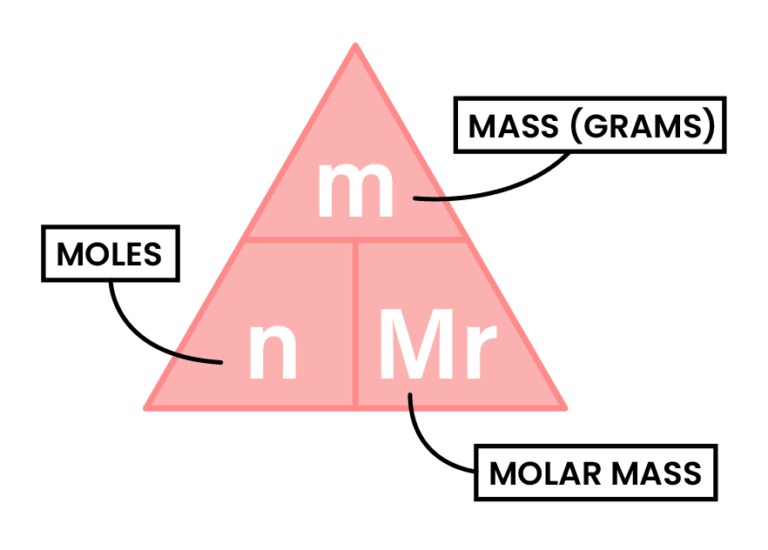
EXAMPLE
How many moles are there in 64g of O2?
- Mole = mass ÷ relative formula mass
- Mole = 64 ÷ (16 x 2) = 64 ÷ 32 = 2g
1.5.5 Calculate reacting masses using experimental data and chemical equations
Information of moles can be obtained from chemical equations
2Na + 2HCl → 2NaCl + H2
Information 1:
Every 2 moles of Na react with 2 moles of HCl to produce 2 moles of NaCl and 1 mole of H2
Information 2:
0.5 mole of Na reacts with 0.5 mole of HCl to produce 0.5 mole of NaCl and 0.25 mole of H2
The number of moles reacted do not have to be whole numbers
Information 3:
mole of Na : HCl : NaCl : H2 = 2 : 2 : 2 : 1
The coefficients in chemical equations show the simplest mole ratio
REACTING MASS
Masses of reactants and products can be calculated from balanced chemical equation:
- Given: reacting mass of one reactant
- Calculate: mass of one product formed
- Step 1: Find moles of the reactant (mole = mass ÷ relative formula mass)
- Step 2: Use balanced equation to find the mole of product (mole ratio)
- Step 3: Find mass of the product (mass = mole x relative formula mass)
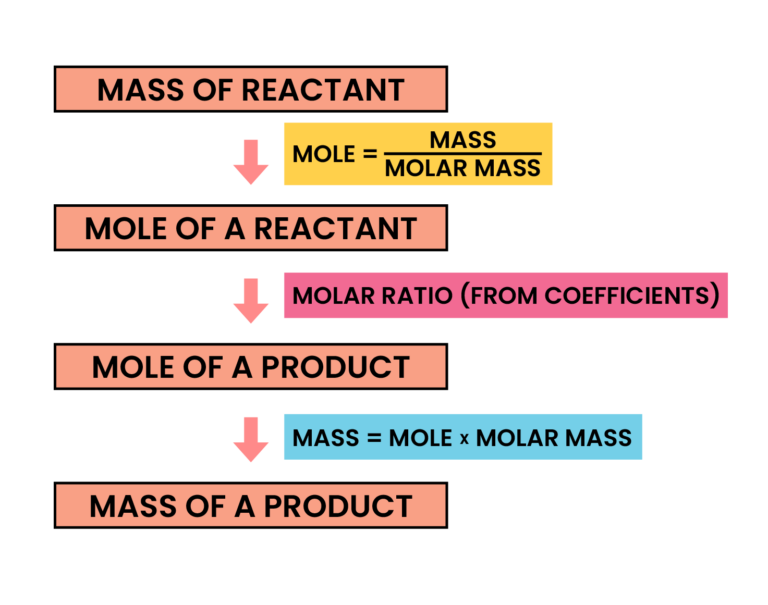
EXAMPLE
If 34.5 grams of sodium metal is completely reacted with excess hydrochloric acid, how many grams of hydrogen gas will be produced according to the following reaction?
2Na + 2HCl → 2NaCl + H2
Given: mass (Na) = 34.5g
Calculate: mass (H2)
STEP 1: FIND THE MOLE OF NA
Mole (Na) = mass (Na) ÷ Mr (Na)
= 34.5g ÷ 23
= 1.5 mol
STEP 2: FIND THE MOLE OF H2 PRODUCED
Mole (Na) : Mole (H2) = 2 : 1
(this can be found from the coefficients in the balanced chemical equation)
If mole (Na) = 1.5 mol from step 1
Then mole (H2) = 1.5 ÷ 2 = 0.75 mol
STEP 3: FIND THE MASS OF H2 PRODUCED
Mass (H2) = mole (H2) x Mr (H2)
= 0.75 mol x (1 x 2)
= 0.75 x 2
= 1.5 grams
1.5.6 Calculate percentage yield
- Actual yield: what is obtained after the experiment (given in question)
- Theoretical yield: what is supposed to be obtained (from reacting mass calculation)
In practice, you never get 100% yield in a chemical process for several reasons
- Some reactants being left behind in the equipment
- The reaction may be reversible
- Product may also be lost during separation stages
1.5.7 Understand how the formulae of simple compounds can be obtained experimentally, including metal oxides, water and salts containing water of crystallisation
CASE 1: METAL OXIDES(MAGNESIUM OXIDE)
- Experimental procedures:
- Weigh some pure magnesium
- Heat magnesium to burning in a crucible to form magnesium oxide (magnesium reacts with oxygen in the air)
- Weigh the mass of magnesium oxide
- Given: mass of magnesium, mass of magnesium oxide
- Calculate: formula of magnesium oxide
- Calculation steps:
- Find the mass of magnesium
- Mole of magnesium = mass of magnesium ÷ molar mass of magnesium
- Mass of oxygen = mass of magnesium oxide – mass of magnesium
- Mole of oxygen = mass of oxygen ÷ molar mass of oxygen
- Calculate ratio of mole of magnesium : mole of oxygen (divide both moles by the smaller number)
- Use the ratio to form empirical formula
EXAMPLE
Some magnesium (Mg) was heated in a crucible to form magnesium oxide. Use the following information to deduce the formula of magnesium oxide.
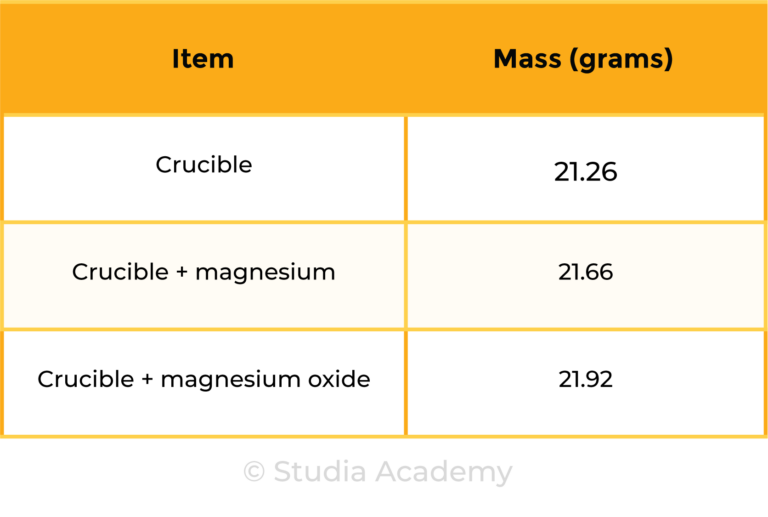
STEP 1: MASS OF MAGNESIUM
Mass of Mg = mass (crucible + magnesium) – mass (crucible)
= 21.66 – 21.26
= 0.40 grams
STEP 2: MASS OF OXYGEN
Mass of O = mass (crucible + magnesium oxide) – mass (crucible + magnesium)
= 21.92 – 21.66
= 0.26 grams
Step 3: mole ratio of Mg and O
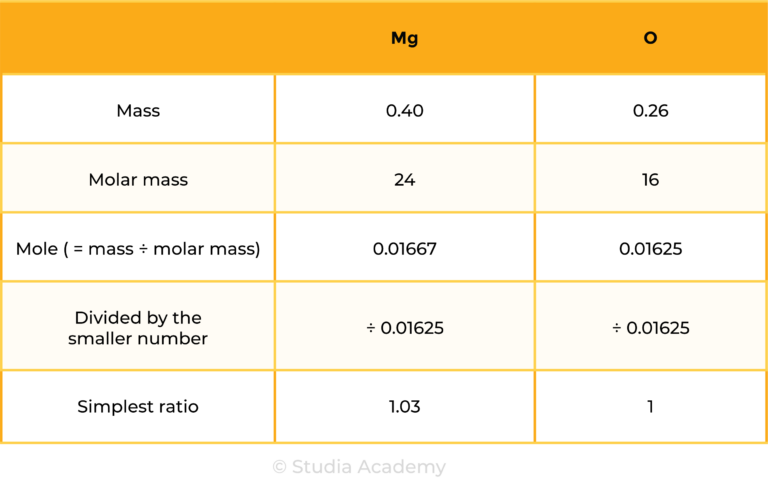
So the formula is MgO.
CASE 2: WATER OF CRYSTALLISATION
- Experimental procedures:
- Weigh some hydrated salt
- Heat hydrated salt to remove water to form anhydrous salt
- Weigh the mass of anhydrous salt
- Given: mass of hydrated salt, mass of anhydrous salt
- Calculate: formula of hydrated salt
- Calculation steps:
- Mass of water = mass of hydrated salt – mass of anhydrous salt
- Mole of water = mass of water / molar mass of water
- Mole of anhydrous salt = mass of anhydrous salt / molar mass of anhydrous salt
- Calculate ratio of mole of anhydrous salt : mole of water (divide both moles by the smaller number)
- Use the ratio to form empirical formula
EXAMPLE
11.25 g of hydrated copper sulphate, CuSO4・xH2O, is heated until it loses all of its water. Its new mass is found to be 7.19 g. What is the value of x?
STEP 1: MASS OF WATER
Mass of water = mass of hydrated salt – mass of anhydrous salt
= 11.25 – 7.19
= 4.06 grams
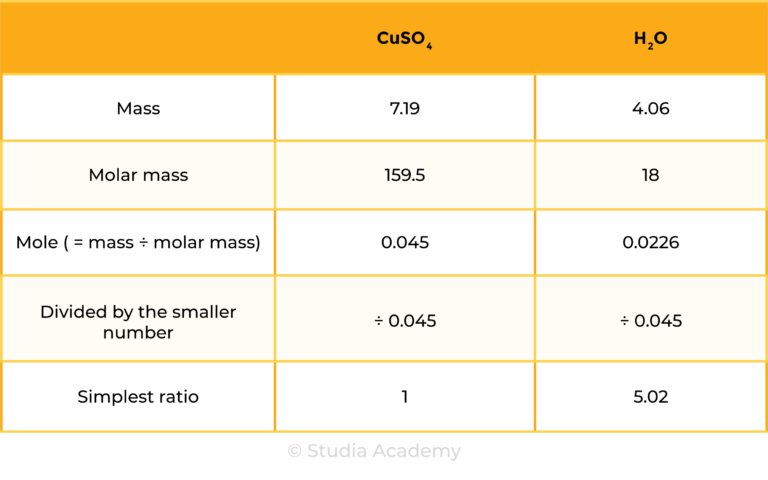
So the formula is CuSO4・5H2O, the value of x is 5.
1.5.8 Know what is meant by the terms empirical formula and molecular formula
EXPIRICAL FORMULA
- Simplest whole number ratio of atoms of each element in a compound
- Remember:
- It is a ratio
- Simplest
- Whole number
MOLECULAR FORMULA
- Actual number of atoms of each element in a compound
Example
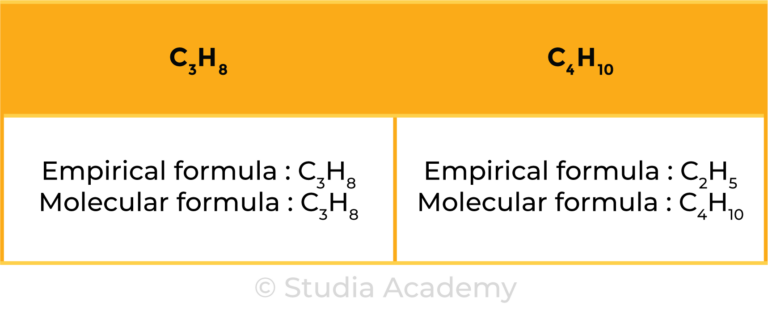
1.5.9 Calculate empirical and molecular formulae from experimental data
CALCULATION OF EMPIRICAL FORMULA
- Given: mass of each element in the compound
- Calculate: empirical formula
- Calculation steps:
- Mole of each element (mole = mass ÷ molar mass)
- Divide all numbers by the smallest number to find the simplest ratio
- Use the ratio to write the empirical formula
EXAMPLE
0.150 g of copper reacts with oxygen from 0.188 g of copper oxide. Find the empirical formula of copper oxide.
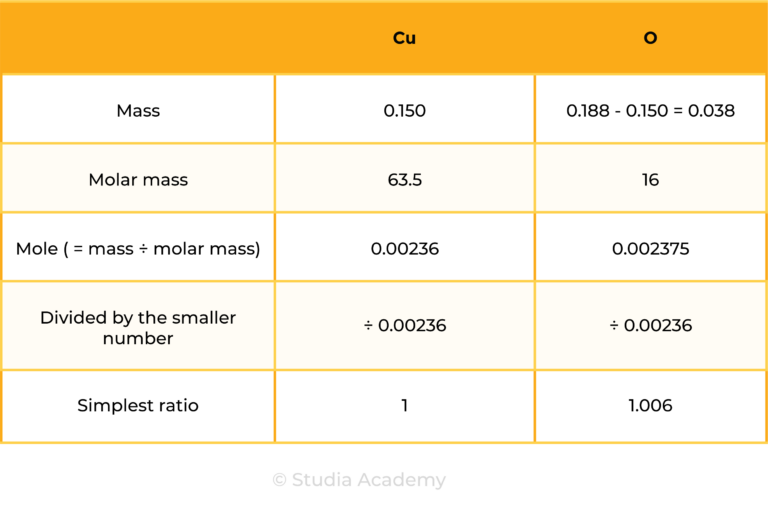
So the empirical formula of copper oxide is CuO.
CALCULATION OF MOLECULAR FORMULA
- Given: molar mass of molecular formula
- Calculate: molecular formula
- Calculation steps:
- Calculate the Mr of molecular formula
- Calculate the Mr of empirical formula
- Divide step 1 by step 2 to find the multiple
- Multiply the empirical formula to find the molecular formula
EXAMPLE
The empirical formula of a compound of boron and hydrogen is BH3. Its molar mass is 28g/mol . Determine the molecular formula of the compound.
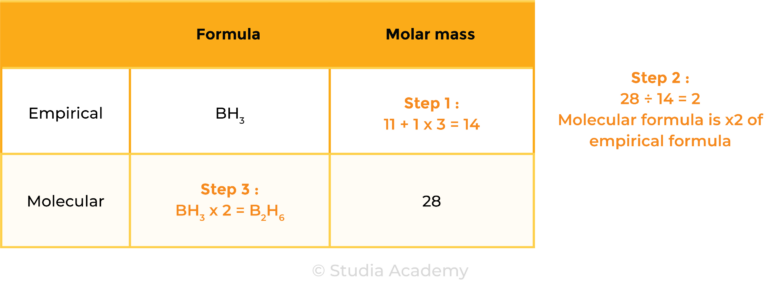
So the molecular formula of the compound is B2H6.
1.5.10C Understand how to carry out calculations involving amount of substance, volume and concentration (in mol/dm³) of solution
CONCENTRATION OF SOLUTION
Solution consists of:
- Solvent
- Solute


- Amount of solute (n): in mol
- Concentration (c): in mol/dm3
- Volume of solution (V): in dm3
- 1 dm3 = 1000 cm3
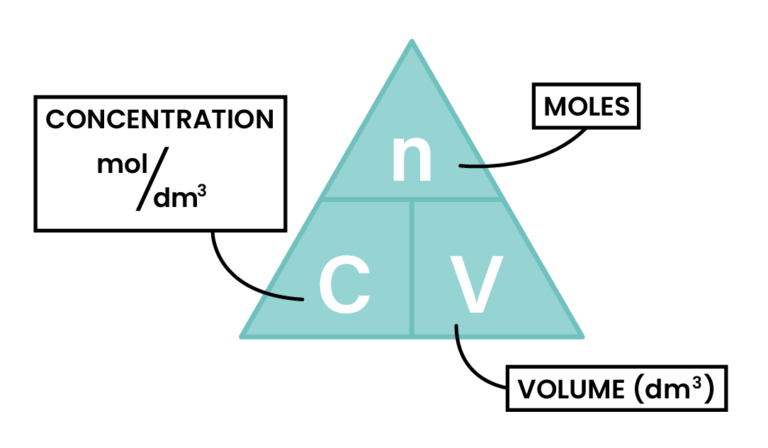
EXAMPLE
0.03 mol of sodium carbonate (Na2CO3) is dissolved in 300 cm3 of water. Calculate the concentration of the solution.
Volume in dm3 = 300 cm3 ÷ 1000 = 0.3 dm3
Concentration = mole of solute ÷ volume of solution
= 0.03 mol ÷ 0.3 dm3
= 0.1 mol/dm3
1.5.11C Understand how to carry out calculations involving gas volumes and the molar volume of a gas (24 dm3 and 24 000 cm3 at room temperature and pressure (rtp))
VOLUME AND MOLE OF A GAS
- Regardless of the type of gas, same amount of gas molecules occupies the same volume under same condition
- RTP: room temperature and pressure
- 20oC
- 1 atmospheric pressure
- Volume of 1 mole of any gas at rtp is 24 dm3 or 24,000 cm3


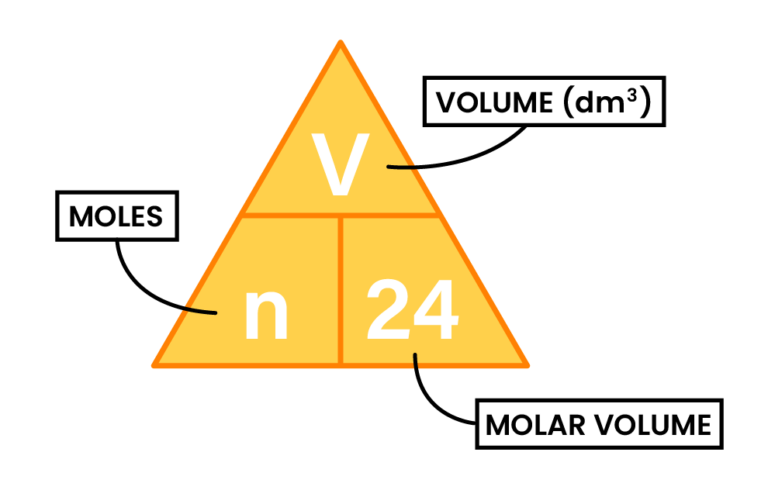
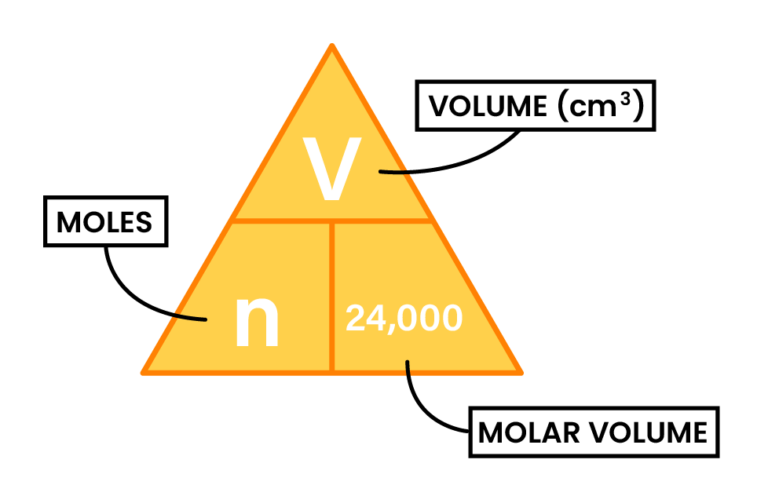
EXAMPLE
Calculate the volume at rtp in cubic centimetres (cm3), of 3 mol of oxygen, O2.
Volume (in cm3) = mole x 24,000
= 3 x 24,000
= 72,000 cm3
1.5.12 Practical: know how to determine the formula of a metal oxide by combustion (e.g. magnesium oxide) or by reduction (e.g. copper(II) oxide)
FORMULA OF METAL OXIDE BY COMPOSITION
- Similar to 1.31
- Calculate the mole of each element in the compound
- Divide all moles by the smallest number to find the simplest whole number ratio
FORMULA OF METAL OXIDE BY REDUCTION
- Step 1: find the mass of metal
- Step 2: calculate the mole of metal
- Step 3: calculate the mass of oxygen
- Step 4: calculate the mole of oxygen
- Step 5: divide all moles by the smallest number to find the simplest ratio
EXAMPLE
An oxide of copper was reduced to copper metal by reaction with hydrogen.
copper oxide + hydrogen → copper + water
Use the data in the table to find the empirical formula of this oxide of copper.

STEP 1: MASS OF COPPER
Mass of Mg = mass (crucible + copper) – mass (crucible)
= 26.82 – 25.61
= 1.21 grams
STEP 2: MASS OF OXYGEN
Mass of O = mass (crucible + copper oxide) – mass (crucible + copper)
= 26.97 – 26.82
= 0.15 grams
Step 3: mole ratio of Cu and O
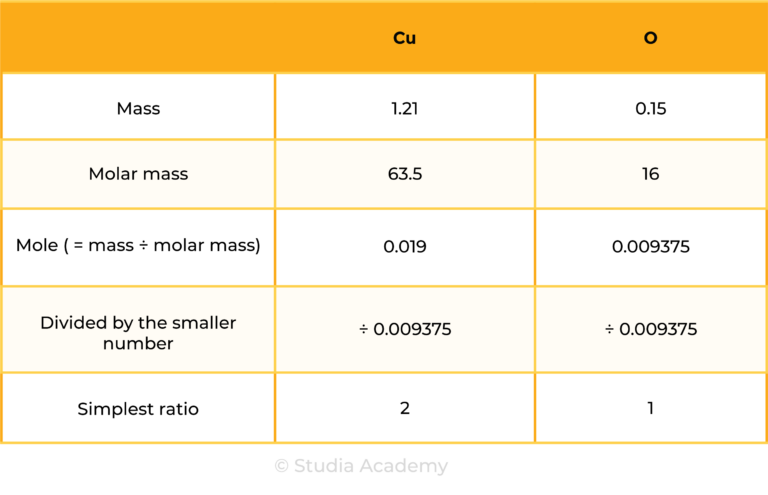
So the formula is Cu2O.

